|
Blisworth Walks & Legging , Blisworth, Northamptonshire, UK. All pictures are presented at relatively low resolution. There will be hundreds of pictures on this site - there is an economic limit to the webspace available. The point of this presentation is that you can see for yourself the extent of the collection and return later as the collection expands - as it surely will. Any interest in copies of a picture at a higher resolution (ie. clarity) should be directed through contacts given in the Blisworth "Round and About" parish council publication or using the comment form on the home page. In some cases the pictures are not available due to copyright restrictions. However, permission has been obtained, where possible, to include them here. Printed below each image is the photographer's name, if known. |
|
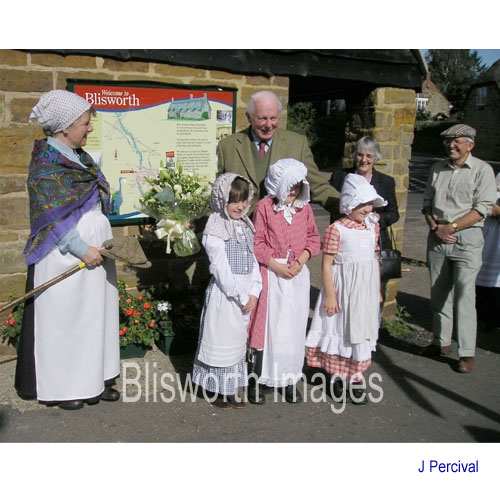 |
40-01 A project, funded by the Local Heritage Initiative, was to establish walks around the village supported by information boards placed at strategic positions and leaflets available in the shops. On the weekend of 23-25th September 2005, celebrations were organised to announce the fruition of this project. Sir Hereward Wake very kindly inaugurated on Saturday 24th the central board placed at the Royal Oak public house. He is pictured here with, left to right, Maureen Smith (Chm. Heritage Society), Jayne Frost (niece of benefactor George Freeston) and Ray Andrews (Trsr. Heritage Society). The boards are designed to appeal to children and three youngsters from the village willingly obliged and dressed up for the occasion and to thank Sir Hereward. They are, left to right, - sorry, it's better not to disclose children's names. |
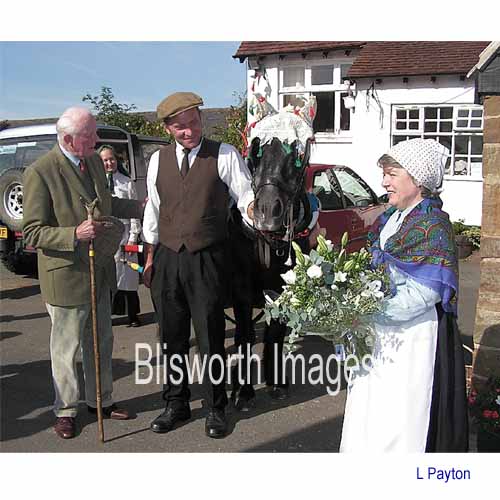 |
40-01b Boat horse "Prince" with his joint owner, see below, was also present at the Saturday ceremony and lead a procession from the Royal Oak down to Candle Bridge.
Lynda Payton is Dep. Chm. & Magazine Ed. of the IWA, Northampton Branch |
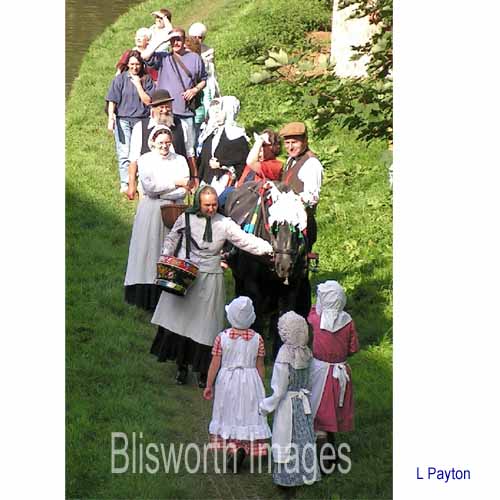 |
40-01c "Prince" was made available for the celebrations by Howard and Morag Yates of Cosgrove. The procession made its way along the tow path to the tunnel portal and then returned to the village. Traditional dress was adopted by many in the party. |
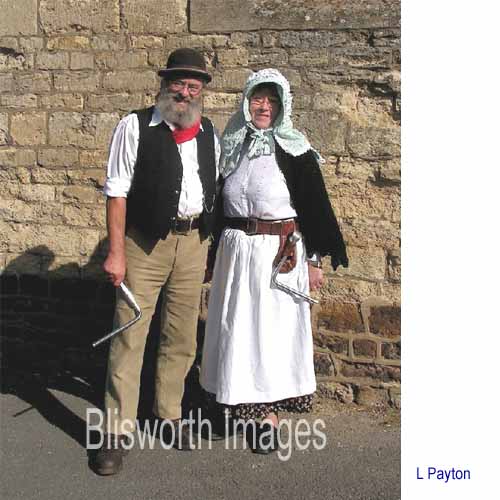 |
40-01d Pictured here are Brian Mayland and Rose Granaghan, well known in the village, in tradition costume complete with their prominent and well polished hand-tools (traditionally called a windlass) used for operating the canal locks. |
|
40-01a Early on the morning of Sunday the 25th Sept., an aspect of Blisworth's heritage was re-enacted - that of "legging" boats through the tunnel, being the means of propulsion in times before steam. The event was organised by the Horseboating Society (formed in 2001, website - www.horseboating.org.uk). This picture, taken by a society member, shows the preparation of the butty "Sunny Valley" at Stoke Bruerne. The society and all those who enjoyed the event are indebted to the owner and the sponsors who made "Sunny Valley" available for their use. It featured in the 1944 Ealing Studios classic film "Painted Boats" in which it was legged through the tunnel. Legging re-enactments have been seldom since then through Blisworth Tunnel - which makes the members all the keener!
Rick Muir is a Society member from Gloucestershire. |
|
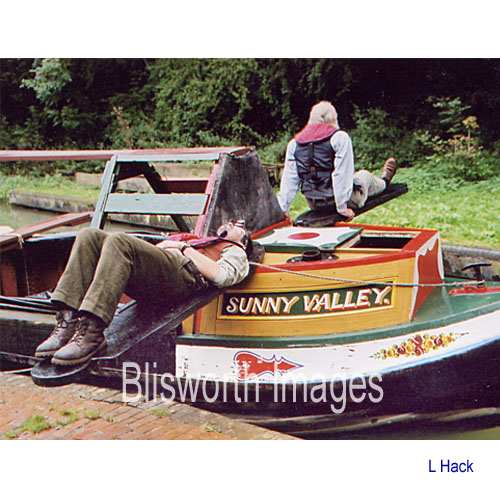 |
40-02 Legging consists of walking the boat against the tunnel wall by a couple of men (or, at least, usually men). They have to lie on fairly wide planks (known as "wings") to extend the width of the boat because the tunnel is wide enough for boats to pass one another. When two legged boats met in the tunnel, the leggers on both had to quickly get up and stow the wings within the width of their boats and then return to the task when the boats had passed. Here, a couple from the Horseboating Society are preparing to start the "leg" from Stoke to Blisworth. They were not expecting to meet anyone because the tunnel was temporarily closed to all other traffic.
|
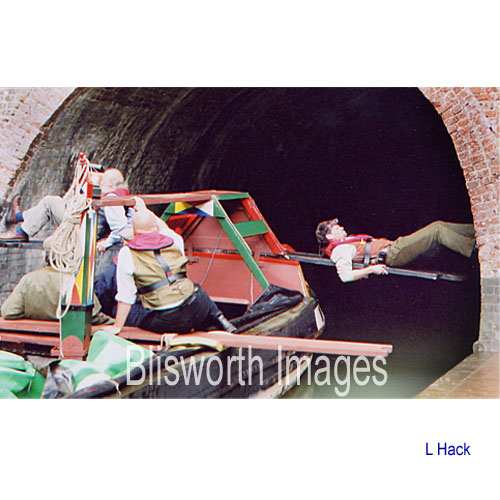 |
40-03 The leggers, wearing life jackets for this reenactment - an improvement on the conditions which would have prevailed in the early 1800's, begin their work at the Stoke Bruerne end of the tunnel. |
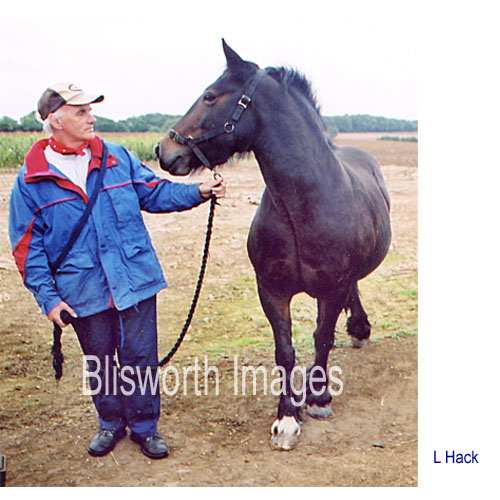 |
40-03a Meanwhile a draught horse named Bonny,
bred and owned by Sue Day, Chairwoman of the Horseboating
Society, was ceremoniously walked over Blisworth Hill accompanied by
a small group of villagers, taking the historic route that the horses
would have taken; up "Boat Lane" in Stoke parish, along the
toll road and down the short ramp in Blisworth.
Bonny is pictured here with Robert Mackenzie who led the horse over Blisworth Hill. Bonny is an experienced boat horse and has also contributed a "traditional" atmosphere to weddings, etc. |
|
40-03b Two pictures taken inside the tunnel given an impression of the legger's task - which entails propelling the boat, pushing hard enough to avoid the wing from rubbing against the wall of the tunnel and remaining safely centred on the wing. Note that the straps visible in the pictures are not a means for securing the legger to the wing. The legger can just lie there because there is little tendency to slide across the wing as long as gentle progress is all that is desired - typically, at just over 1 mph. Compare that with conditions in the early 19th century when boats were legged at higher speeds and when life could be "expended with less conscience". It seems legging was hazardous then; a GJC Company minute from 1811 reads; " .. recommend to strap themselves to a short cord affixed to the boat to prevent their being drowned", (Hadfield's "British Canals" 8th Ed., page 44). |
|
| 40-03c The leggers were
Nigel Dix (for the whole length of the tunnel) and others who took
turns: Derek Armstrong, Pat Crecraft, Neil Gore, Adrian Lovett, Rick
Muir, Sean Neill and Sue Day. Legging is definitely not just for
men. They say that it is quite easy to acquire the knack and,
physically, the job is not arduous but requires fitness and
agility. Nigel Dix, on the right wing, is a long distance runner
and "wasn't even warm" after the mile and three quarters
session! |
|
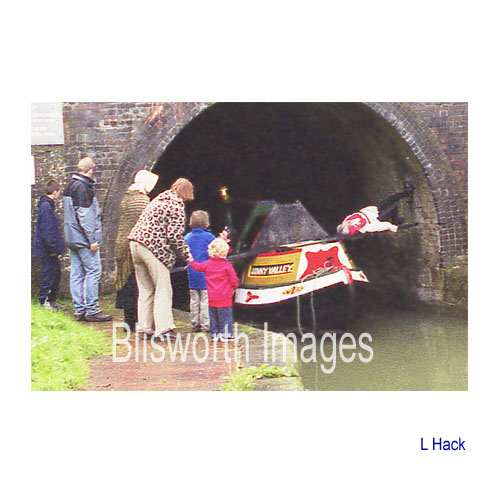 |
40-04 After an hour and about forty minutes the leggers emerged at the Blisworth end of the tunnel. It would have been quicker without the frequent changes of leggers which were made to allow anyone willing to give it a try for a few hundred yards. |
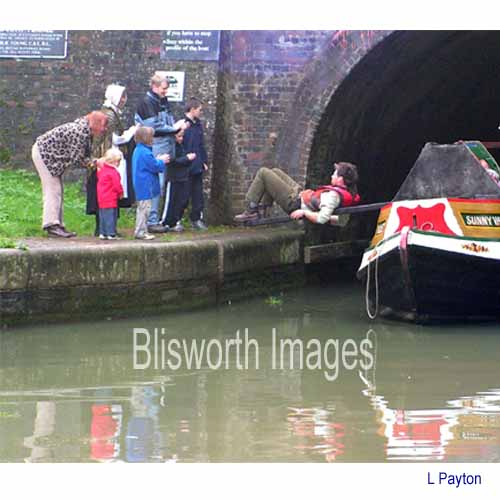 |
40-05 Nigel Dix for his long stint, indeed the whole team, were met with applause as they emerged. Quotes from members of the leggers team include: "My broken leg of 2001 still gives me problems. I did get pains later but it was worth it. I love legging". "The walk back was probably more tiring than the passage through the tunnel, which we all thoroughly enjoyed and would happily have done again. A very successful day, and thanks are due to all concerned". "The legging was not arduous. It was the months of e-mails and phone calls about arrangements and permissions that were wearying". |
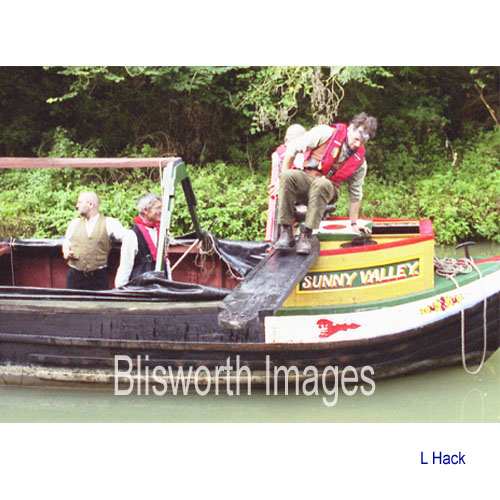 |
40-06 The leggers get off their perch and the boat is readied for the next stage. The wings, which are usually bespoke made for each boat, are stowed away. |
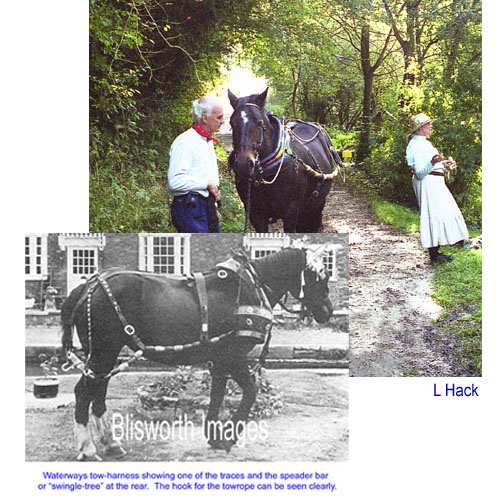 |
40-07 Meanwhile, Bonny was arriving at the north tunnel portal and was harnessed up. Sue Day is pictured here giving a short presentation to explain the workings of the harness. It is designed to convey the load evenly to both sides of a padded collar. A rope (traditionally known as a trace) runs backwards from the collar on both sides. One of these, colourfully decorated, can be seen in the upper picture. The ropes are attached to the ends of a spreader bar (which is about three foot wide) behind the horse and the tow rope is attached to the centre of that bar. By this means, the load is evenly distributed (please refer to the black and white picture for clarification). Along the sides of the horse, the ropes are held out by means of being passed through eyes (wooden bobbins) so that no chafing can occur. In the upper picture, one of the extensions by the flank, which carries an eye, can just be made out.
|
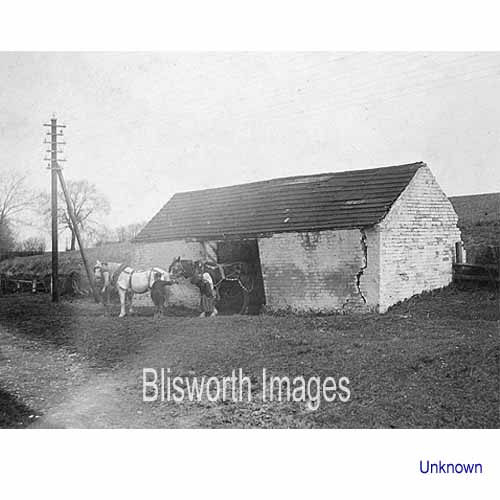 |
40-07a This c. 1910
picture also shows boat horses with similar harnesses. The picture
has been said to relate to the Blisworth Tunnel but its location in the
"lie of the land" does not seem to fit anywhere near the north
portal. Clearly, from the position of the telegraph pole, the shed
is alongside a path or road with a large verge of grass. It is set
into a bank and has high ground behind it.
In the 1838 map of the tunnel mouth area there is a small stable marked near the tunnel mouth. The same 'hut', perhaps, is visible in the picture of sailing on the canal. But because of the lie of land and no buildings in the background to the picture, this is not the same hut. |
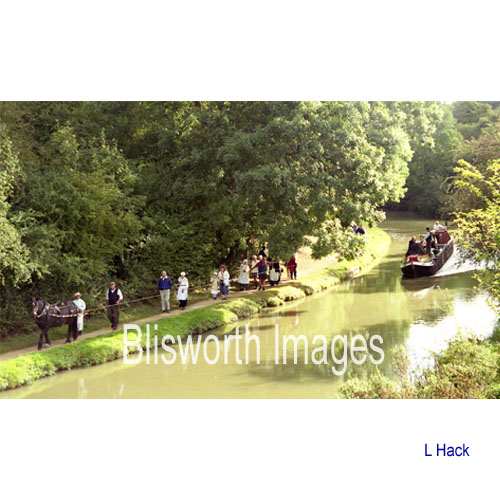 |
40-08 A long rope is generally
used in order to minimise the force which could pull the horse on the
tow path towards the water. The rope is attached to the boat
centrally and some distance back from its bow. This measure
ensures that the tension on the rope has little steering effect on the
boat. Horse and boat are pictured here
rounding the last bend before Mill Bridge in Blisworth.
The sun decided to come out at this leisurely stage in the re-enactment. On occasions when horses meet on the path, one of the towropes would be raised with the use of a long forked pole so that a horse with its boat could pass underneath it. However, the traditional way of dealing with this problem was to stop one of the horses at the correct moment and allow its boat to continue to drift. Their long towrope then sank into the water and was tidied on the footpath so that the other horse, with its boat, could continue over the lowered rope. If a horse and boat needed to pass a moored boat then the towrope would be dealt with manually. |
|
Footnote: Note that towropes were made of cotton which has the right amount of stretch. They have left grooves, accumulated over the years, in the edges of bridges as shown in image number 08-45. |
|
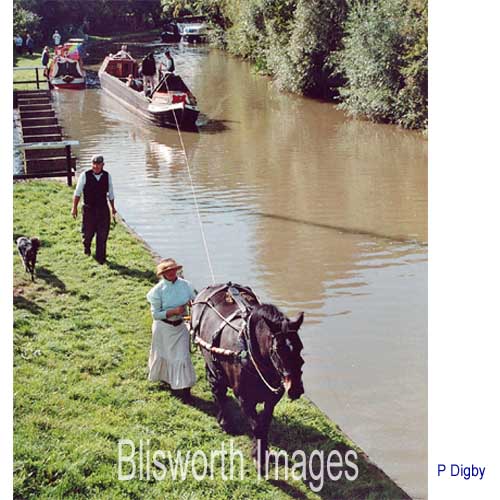 |
40-08a This picture shows the group approaching candle Bridge. |
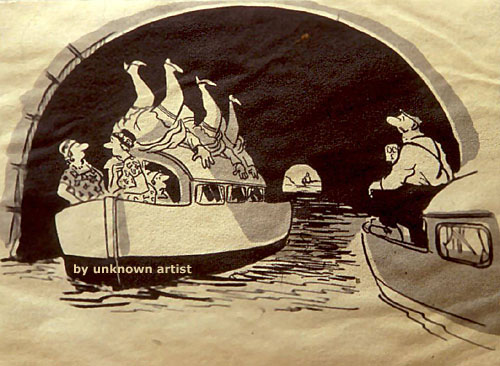 |
Cartoonist please step forward! This was found in George Freeston's tunnel box - an original ink on paper. |
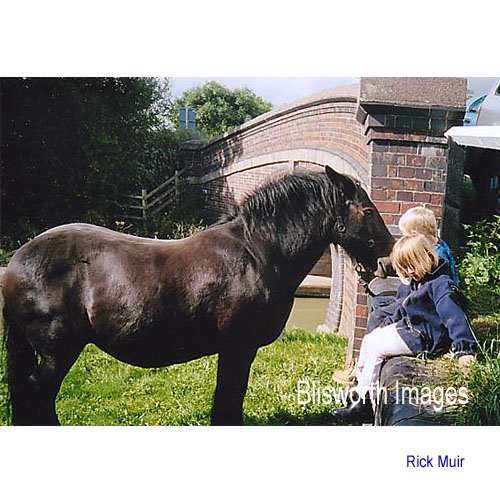 |
40-09 The party proceeded to Blisworth Arm - many of them then returned on foot to Stoke Bruerne to round off the day in the customary way. At the Arm, Bonny could meet up with an appreciative pair once the work was done.
It is very much appreciated that the Horseboating Society (website - www.horseboating.org.uk) were able to provide not only some background which improved this page but also one or two corrections to errors which a non-cognizant might make. |
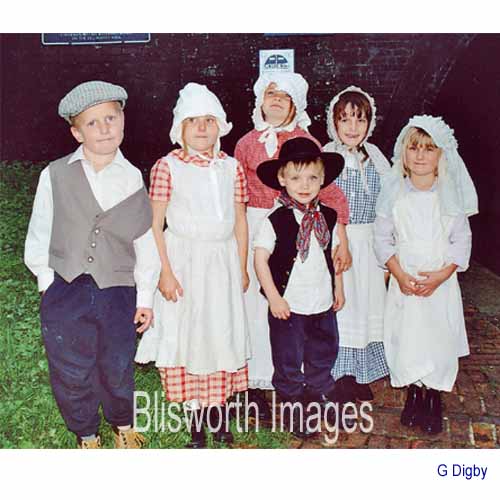 |
40-11 This picture of children enjoying their traditional costumes was taken at the tunnel mouth. |
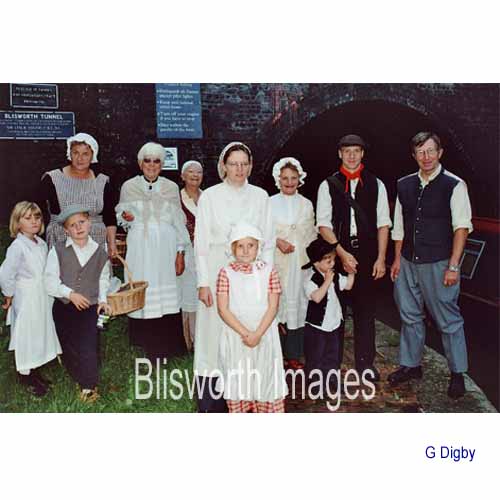 |
40-12 This is a group of some of the organisers and helpers and some of the children - all in the traditional costume. |